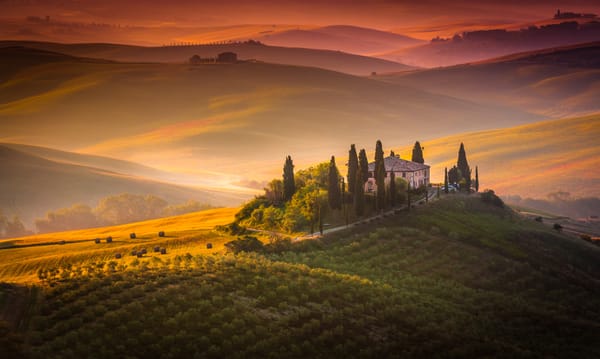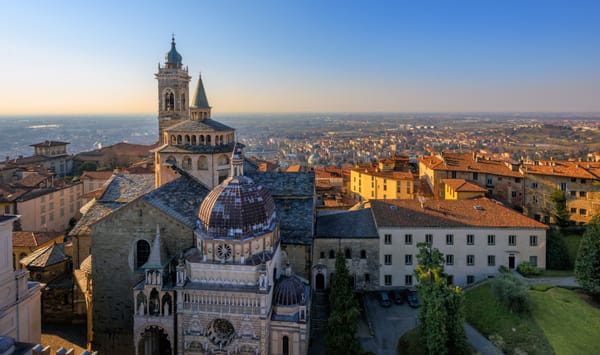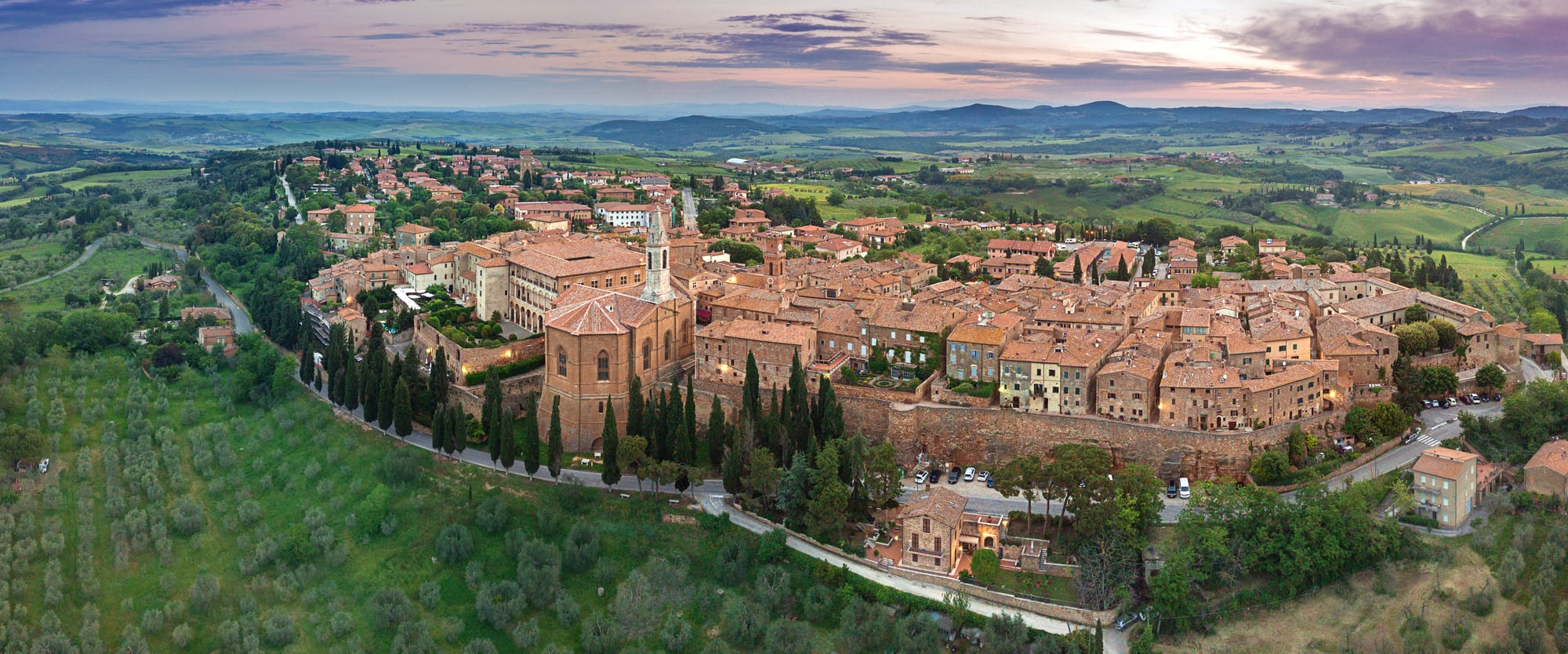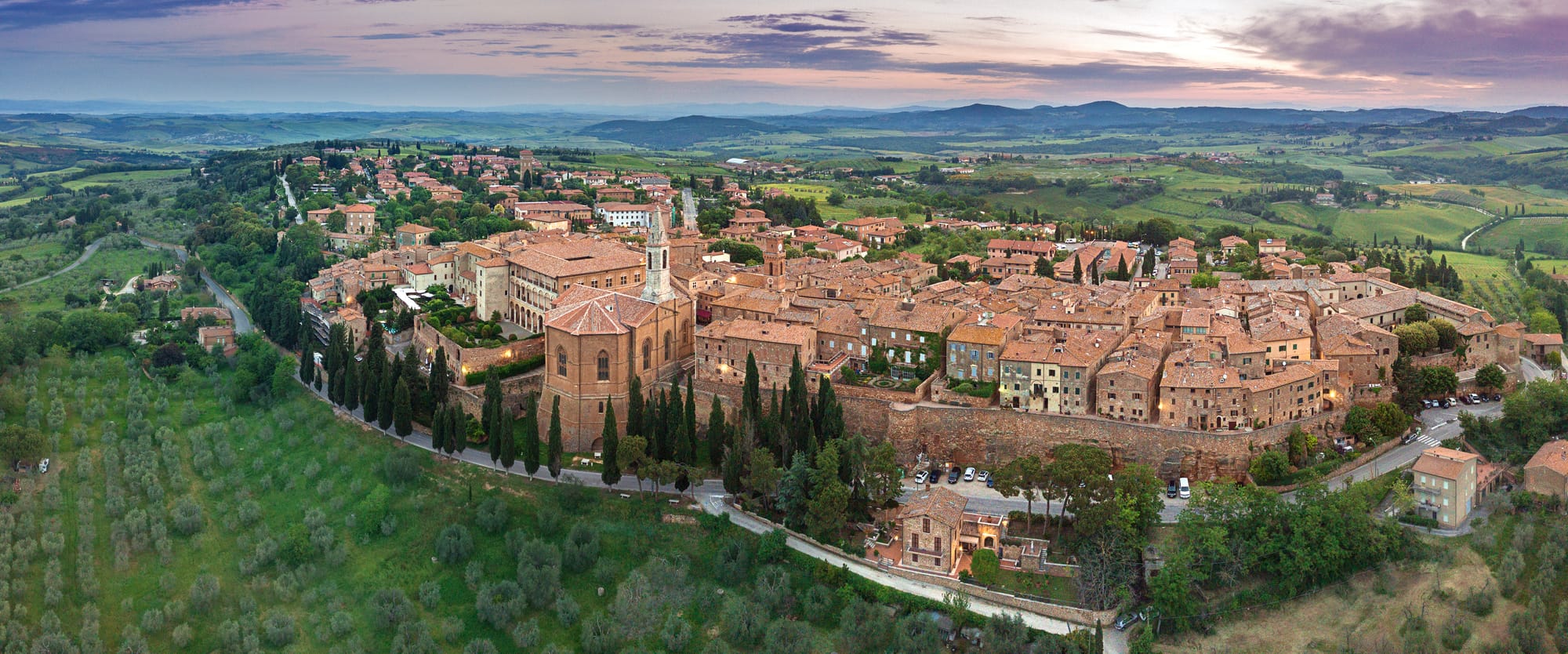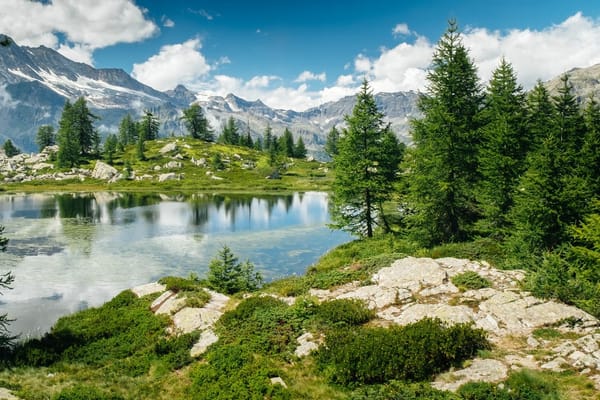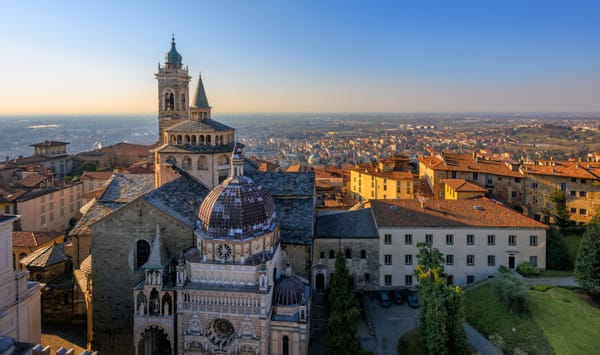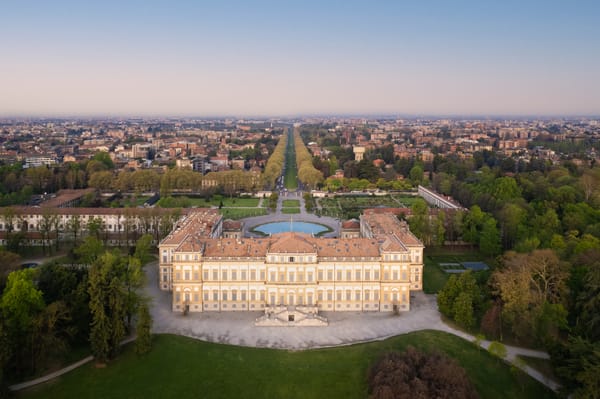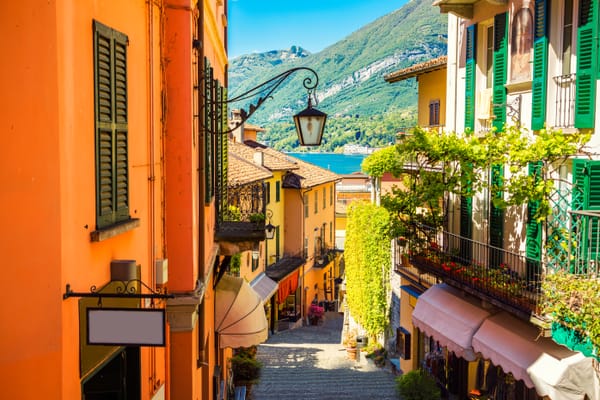In the heart of the Val d'Orcia, a town rises that is much more than a destination: it's an idea. Pienza is an ambition realized, the dream of the Renaissance brought to life in travertine stone. Conceived by the great humanist Pope Pius II, this is the "ideal city"—a revolutionary masterpiece of harmony and urban design, built to reflect perfection on Earth.
But to visit Pienza is to do much more than just admire its architecture. It's a deep journey into the very soul of Tuscany. It's the wonder of breathtaking views that open up at the end of a quiet alley, the intense aroma of Pecorino cheese aging in historic cellars, and the palpable sense of peace that pervades its streets. Here, history, art, and authentic flavors merge to create an unforgettable experience.
If you're looking to discover all the most useful and significant information about Pienza, you've found the essential resource you're looking for.
In this article:
To learn more about the stunning Val d'Orcia, please see our dedicated guide.
Why visit Pienza: Tuscany's ideal Renaissance city
Essentially, Pienza is a must-visit because it offers a unique opportunity to step into the world's most perfectly preserved Renaissance town, set within the breathtaking landscape of Tuscany's Val d'Orcia. It’s a destination that appeals to lovers of history, art, and unforgettable sensory experiences.
Born from the vision of Pope Pius II, Pienza is a masterclass in humanist urban planning. The result is a town of extraordinary beauty and harmony. Here are the top reasons why Pienza deserves a top spot on your itinerary.
1. You can step into a Renaissance masterpiece Pienza is not just a town with Renaissance buildings; it is a Renaissance concept. Conceived as the "ideal city," it was built with perfect harmony in mind. A visit here feels like stepping into a living museum, offering the most perfectly preserved example of 15th-century humanist urban planning in the world.
2. To witness iconic Val d'Orcia views The town's location is as magnificent as its architecture. Perched on a hill, Pienza provides some of the most famous and breathtaking panoramic views over the rolling, cypress-studded hills of the Val d'Orcia, a UNESCO World Heritage landscape that has inspired artists for centuries.
3. It's an unforgettable sensory experience A visit to Pienza engages all the senses. It’s the savory aroma of its world-famous Pecorino cheese wafting from shop doorways, the quiet echo of footsteps on ancient travertine stone, and the peaceful atmosphere that rewards slow travel and quiet observation.
4. The grandeur feels intimate and accessible Unlike larger, more overwhelming cities, Pienza's Renaissance grandeur feels personal. You can intimately explore the piazzas, palaces, and quiet alleys designed by architect Bernardo "il Rossellino," connecting with a unique and powerful chapter of Italian history in a way that feels both profound and personal.
The history of Pienza: a pope's vision and an architect's genius
Pienza was not born from centuries of slow evolution; it was willed into existence by the singular vision of one man and the skill of another. It represents one of history's most ambitious examples of Renaissance urban planning, a place where humanist philosophy was rendered in travertine stone. To understand Pienza is to understand the two remarkable men who conceived it.
The humanist pope: Enea Silvio Piccolomini (Pope Pius II)
Before he was Pope Pius II, Enea Silvio Piccolomini (1405-1464) was one of the most celebrated intellectuals of his age. His background was the driving force behind the creation of Pienza.
- A Renaissance humanist: Born in the humble village of Corsignano (Pienza's original name), he was a poet, diplomat, and author. His extensive travels exposed him to Europe's great cities and the burgeoning classical revival in Italy.
- A vision for his birthplace: Deeply influenced by the classical ideals of order and harmony, and inspired by architects like Leon Battista Alberti, Pius II harbored a revolutionary dream: to transform his modest home town into a physical embodiment of those principles—a utopian city built for peace, dignity, and diligence.
The architect of the vision: Bernardo Rossellino
To execute this grand vision, Pope Pius II turned to the Florentine architect and sculptor Bernardo Rossellino (1409-1464), a student of the great Filippo Brunelleschi.
- A florentine master: Rossellino was renowned for his ability to blend the classical principles of proportion and symmetry with practical construction.
- The pragmatic visionary: He was the perfect man for the job because he could translate the abstract humanist ideals of his associate, Alberti, into physical reality, making him the ideal instrument for the pope's ambitious project.
The creation of Pienza: designing the ideal city
In 1459, the project began. In a breathtakingly short period of just three years (1459-1462), the medieval village of Corsignano was razed and reborn as Pienza. The project's core was a completely new urban layout centered on a magnificent main square.
- A rational urban layout: Rossellino rejected the winding, organic layout of medieval towns. He straightened the main street, the Corso il Rossellino, to create a clear, rational axis leading to the main square.
- The theatrical main square (Piazza Pio II): The piazza itself was a masterstroke. Its trapezoidal shape was a deliberate design choice that uses the principles of perspective to make the space feel harmonious and the cathedral's facade appear even more majestic.
- A cohesive architectural ensemble: On this single "stage," Rossellino arranged the four key buildings of civic and religious life in perfect dialogue: the Cathedral, the Papal Palace (Palazzo Piccolomini), the Bishop's Palace, and the Town Hall.
This was a city built not just for function, but for meaning. Pienza remains the most enduring legacy of a humanist pope and his brilliant architect—a small town in the Val d'Orcia that stands as a timeless monument to the audacious dream of building a better world.
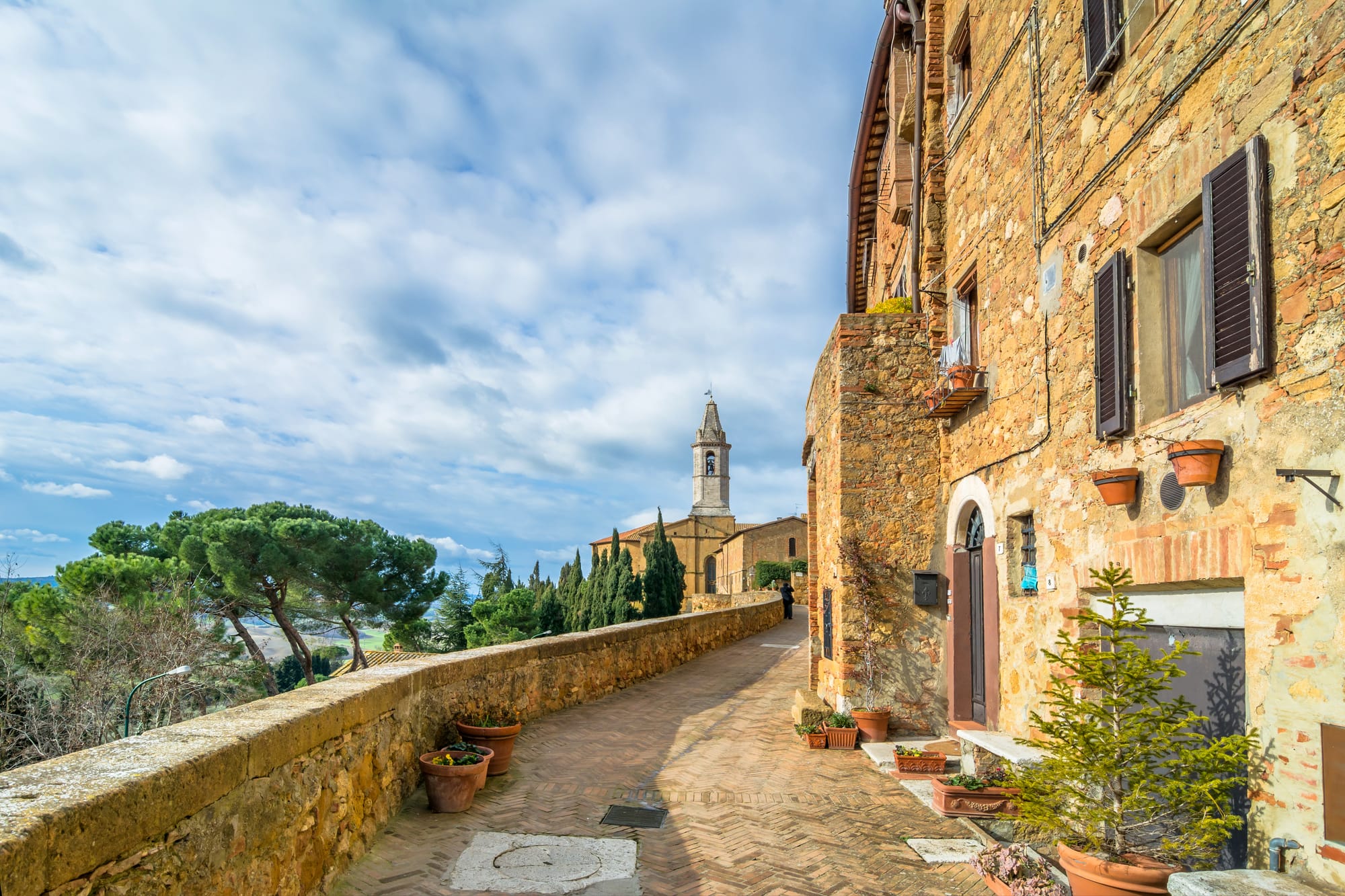
What to see in Pienza: a journey through Renaissance harmony
The heart of Pienza's utopian design is its central square, a cohesive ensemble that defines the town's identity. Nearly all of Pienza's essential sights are located on or just steps from this single piazza, making it the perfect starting point for your exploration.
1. Piazza Pio II: the center of the ideal city
This trapezoidal piazza is a masterpiece of Renaissance perspective and architectural balance. Designed by architect Bernardo "il Rossellino," it was engineered to appear larger and more majestic than its actual size. This square is the anchor of Pope Pius II's vision and the location of the town's four most important buildings.
2. Cattedrale dell'Assunta (The Duomo)
Dominating the piazza, the cathedral's travertine facade is pure Renaissance, inspired by the work of Leon Battista Alberti. Inside, however, the style shifts dramatically to a German-inspired Hallenkirche (hall church), a bright and luminous space specifically requested by the well-traveled Pope Pius II.
- Don't Miss: The exquisite altarpieces commissioned from the finest Sienese artists of the 15th century.
- Insider Tip: Look down at the floor near the apse. You can see visible signs of subsidence, a fascinating engineering challenge that has plagued the cathedral almost since its construction due to unstable ground.
3. Palazzo Piccolomini
This magnificent palace served as the private residence of Pope Pius II and is a clear homage to Florence's Palazzo Rucellai. A visit offers a fascinating glimpse into the life of a Renaissance pope.
- Key Feature: The stunning three-tiered loggia at the rear of the palace, which opens onto a beautiful "hanging garden."
- The View: The loggia offers one of the most sublime and commanding panoramic vistas over the Val d'Orcia in all of Tuscany, perfectly embodying the humanist ideal of harmony between architecture and nature.
4. Palazzo Borgia (The Diocesan Museum)
Located opposite Palazzo Piccolomini, this is a must-visit for art lovers. The museum provides essential context to the artistic fervor of the period.
- What's Inside: It houses a rich collection of religious art, including beautiful Sienese panel paintings, intricate tapestries, and precious artifacts that once adorned the cathedral.
5. Corso il Rossellino and the hidden alleys
Beyond the main piazza, the entire town is a delight to explore.
- Main Street: The central artery, Corso il Rossellino, is lined with artisan shops, cafes, and purveyors of local delicacies like Pecorino cheese.
- Explore Further: Wander off this main street to discover quiet lanes with evocative names like Via dell'Amore (Love Street) and Via del Bacio (Kiss Street), which offer charming corners and sudden, breathtaking views of the countryside.
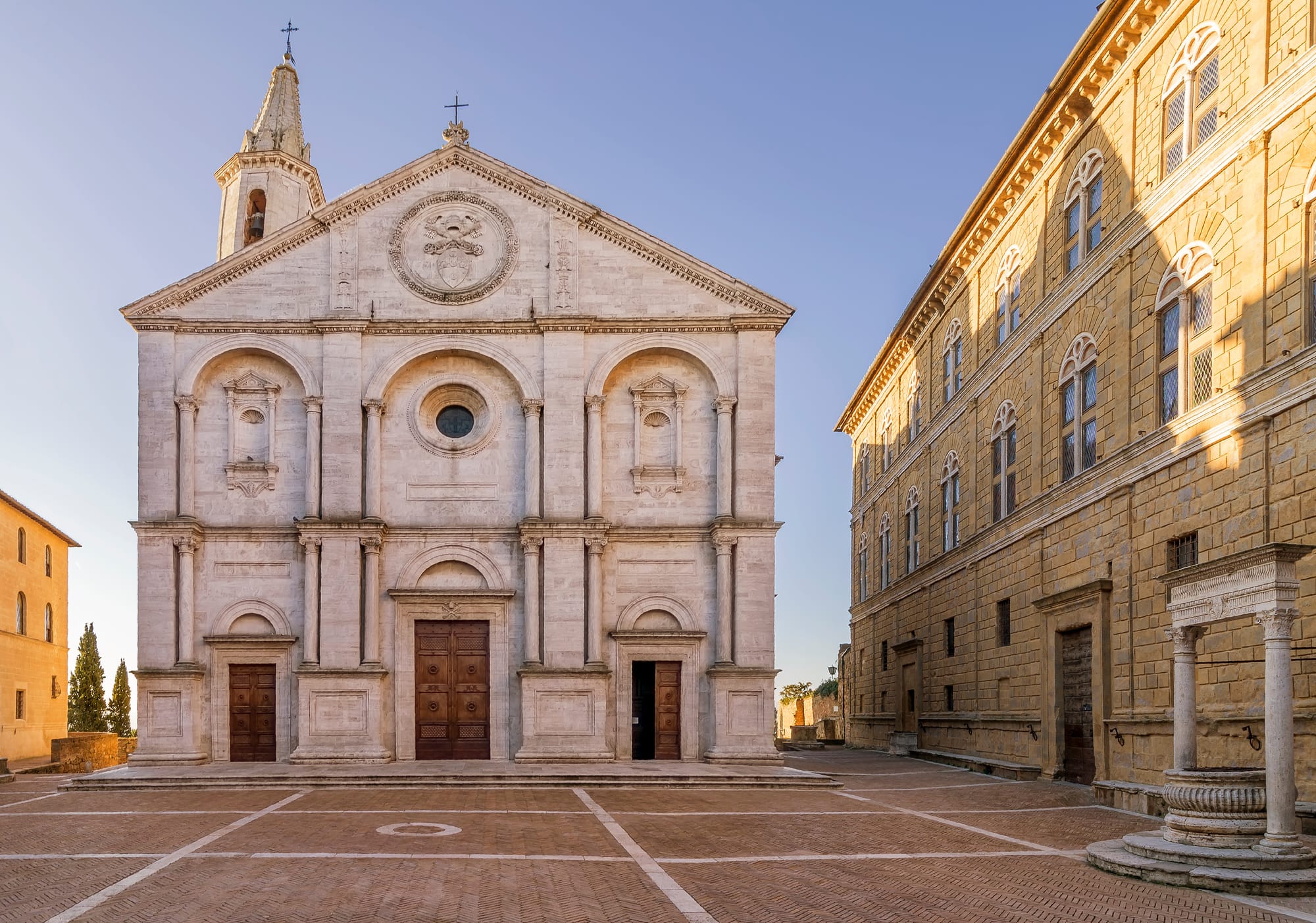
Pienza off the beaten path: authentic experiences and hidden gems
While the central piazza is a must-see, the true spirit of Pienza often reveals itself to those who venture a little further. Here are three hidden gems to discover just beyond the main tourist trail.
Explore the medieval hamlet of Monticchiello
Just a short, scenic drive from Pienza lies Monticchiello, a tiny, perfectly preserved medieval hamlet that feels like a step back in time. Enclosed within its formidable fortified walls and entered through the impressive Porta Sant'Agata, this village offers a stark, beautiful contrast to Pienza's Renaissance order. Here, the joy is in the discovery: wandering through a maze of narrow stone alleys, stumbling upon hidden courtyards, and admiring the stunning views of the Val d'Orcia from a different vantage point.
- Don't miss: The world-famous Teatro Povero (Poor Theatre). Each summer, typically from mid-July to mid-August, the townspeople themselves write and perform a play based on their own lives and history. It's a remarkable and deeply authentic cultural experience that captures the true spirit of community in Tuscany.
Discover the Pieve di Corsignano
A short, pleasant walk downhill from the town walls leads to this enchanting Romanesque church. This is the ancient heart of the area, predating Pienza's Renaissance transformation, and the place where Pope Pius II himself was baptized. The church feels ancient and deeply spiritual.
- What to look for: The unique circular portal adorned with primitive carvings and the original baptismal font inside are the real treasures.
Explore the 'Case Nuove' neighborhood
Wander through the neighborhood just west of the historic center to see a different side of the "ideal city." This area, known as the "Case Nuove" or new houses, was also part of Pius II's grand plan.
- Why it's interesting: It was intended to provide quality housing for the town's less affluent citizens, demonstrating a surprisingly modern approach to social urban planning in the 15th century.
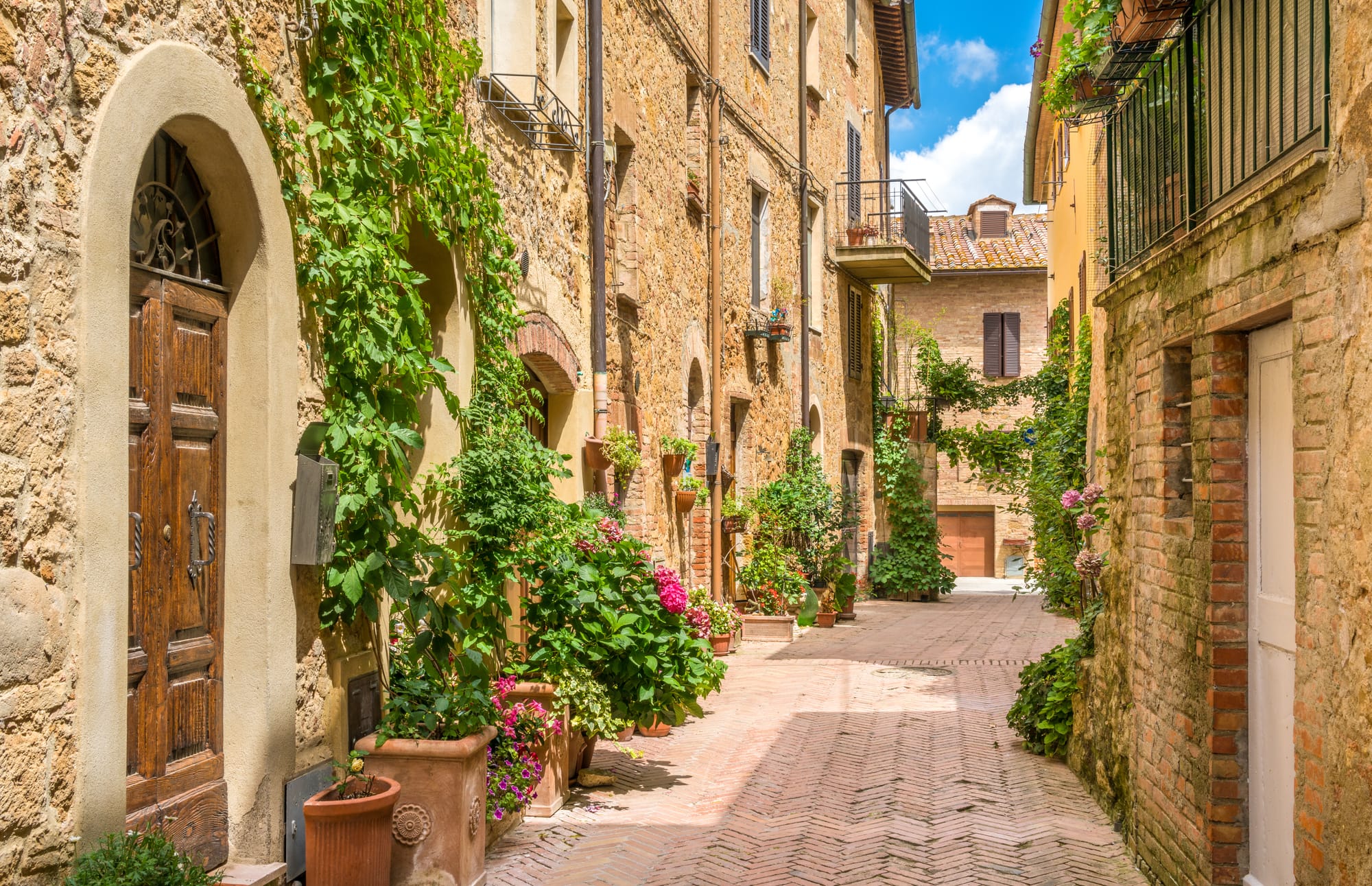
The taste of Pienza: a guide to pecorino, pasta, and wine
A visit to Pienza is incomplete without indulging in its culinary treasures. The town is the undisputed capital of one of Tuscany's most famous products, a gastronomic emblem of the Val d'Orcia itself.
Pecorino di Pienza: the king of Tuscan cheese
What makes Pecorino di Pienza distinct from all other sheep's milk cheeses in Italy is a perfect trinity of factors: the unique milk, the artisanal process, and the unmistakable terroir of the Val d'Orcia. The flavor begins in the landscape itself, in the aromatic herbs—wild mint (mentuccia), thyme, savory, and wormwood—that grow wild in the clay-rich pastures (crete senesi). The local sheep graze on these herbs, infusing their full-fat milk with a sweetness and herbaceous complexity that cannot be replicated.
The cheesemaking process is an art form, traditionally using only calf rennet (caglio di vitello), which results in a gentler, less piquant flavor than the more common lamb rennet. The curds are hand-pressed into forms and then aged on wooden boards in cellars, where they develop their final character.
- Types of Pecorino to try:
- Fresco: Aged for about 30 days, this cheese is soft, delicate, and milky.
- Semi-aged: Aged for 2 to 5 months, it develops a richer, nuttier flavor and a firmer rind, often treated with olive oil.
- Aged: Aged for six months or more, resulting in a hard, complex, and granular cheese with a wonderfully sharp, savory flavor perfect for grating or savoring in small pieces.
- Specialty and aged varieties:
- Under Wraps (Sottofoglia or Sottocenere): Look for unique varieties aged using ancient preservation techniques. Some are wrapped in walnut leaves or aged under ash, each method imparting a distinct layer of earthy flavor.
- Fermented (Sottovinaccia): A truly special variety where aged cheese wheels are placed in barrels and covered with the vinaccia, or fermented grape skins and seeds left over from the wine harvest. This process imparts a pungent, wine-infused aroma and a sharp, fruity taste.
- Spiced (Speziato): These cheeses are flavored from the inside out. Ingredients like black peppercorns, spicy red chili flakes (peperoncino), or even black truffle shavings are mixed directly into the milk curd before it's pressed, infusing the entire wheel with their potent flavor.
- Perfect pairings: Enjoy aged pecorino with local acacia honey or fruit preserves like fig jam; the sweetness perfectly balances the cheese's savory notes. It pairs beautifully with a robust red wine from the region.
- Every year, during the first weekend in Septeber, Pienza organizes a Festa del Cacio, in honour of its local cheese.
Pici: Tuscany's ancient, hand-rolled pasta
While Pecorino is the star, the essential first course in Pienza is pici. This is not merely pasta; it's a direct link to the region's ancient past. With roots that may stretch back to the Etruscans, pici is the definitive pasta of Tuscan cucina povera (peasant cooking).
Made from a humble dough of just flour and water (hardly ever with eggs), its name likely comes from the verb appicciare, describing the traditional motion of rolling and stretching the dough by hand into long, thick, irregular strands. This was the food of farmers, a communal and meditative act performed by the women of the household. To eat pici is to taste a piece of Tuscan history. It's often served with one of these classic sauces:
- Aglione: A rich and surprisingly delicate sauce made from a special variety of giant local garlic and ripe tomatoes.
- Cacio e Pepe: A simple yet sublime sauce of black pepper and grated Pecorino di Pienza, where the pasta water and cheese emulsify into a creamy coating.
- Briciole: A classic peasant sauce of toasted breadcrumbs, garlic, and olive oil, celebrating the resourceful spirit of Tuscan cooking.
Orcia DOC: the hidden gem of Tuscan wine
Nestled between its world-famous neighbors, Montalcino and Montepulciano, lies the Orcia DOC wine region. This is the Val d'Orcia's "hidden gem," a designation that produces exceptional wines from the same prestigious terroir as its celebrated counterparts but often without the high price tag.
The reds are made primarily from the Sangiovese grape, yielding robust, elegant wines with notes of cherry, red berries, and a firm structure that makes them the perfect companion to Pecorino and pici with a meat ragù. When dining in Pienza, look for Orcia DOC on the wine list; it's a savvy choice that offers a truly authentic taste of the valley.
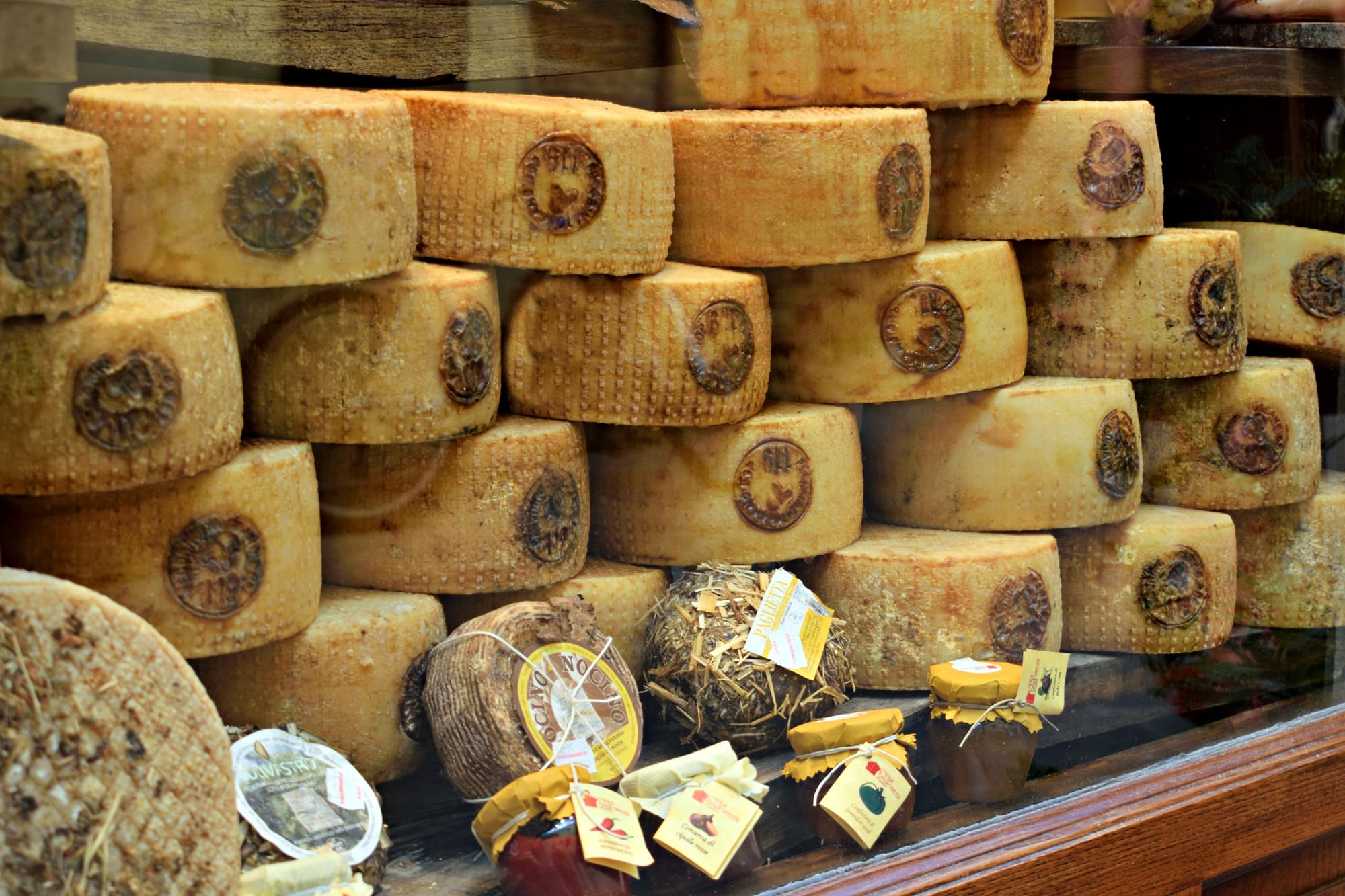
How to plan your trip to Pienza: a practical guide
The best time to visit Pienza
The ideal times to visit Pienza are during the shoulder seasons when the weather is beautiful and the crowds are smaller.
- Spring (April to June): The landscape is incredibly vibrant, with lush green fields and blooming red poppies.
- Autumn (September to October): The weather is pleasant, and the countryside glows with the warm, golden hues of the harvest season.
Visiting during these periods allows you to avoid the intense heat and larger crowds of the peak summer months.
Getting there and around
While Pienza is a rural destination, it's well-connected within Tuscany.
- By car (Highly Recommended): Driving is the best way to reach Pienza and explore the Val d'Orcia. It's approximately a 45-minute drive from Siena and a 2-hour drive from Florence.
- parking: Pienza's historic center is a ZTL (Limited Traffic Zone). You cannot drive inside. Look for the large, clearly marked paid parking lots located just outside the town gates.
- Public transport: Bus connections from nearby towns like Siena exist, but they can be infrequent. If you rely on public transport, be sure to check the latest schedules in advance.
- Getting around: Pienza itself is very compact and is best explored on foot.
Recommended duration of stay
While you can see the main sights of Pienza in a single day, this approach misses its tranquil charm.
To truly appreciate the town and use it as a base for exploring the region, a stay of 2-4 nights is highly recommended. This gives you ample time for leisurely exploration, visiting local Pecorino cheese farms, and taking day trips to nearby towns like Montepulciano and Montalcino.
Where to stay: hotels and agriturismi
Pienza offers a wonderful range of accommodations to suit different travel styles.
- In the historic center: You'll find charming boutique hotels and B&Bs, perfect for those who want to be in the heart of the action.
- In the surrounding countryside: For a more immersive and relaxing experience, consider an agriturismo (farm stay). These often feature stunning views, swimming pools, and an authentic connection to the Tuscan landscape.
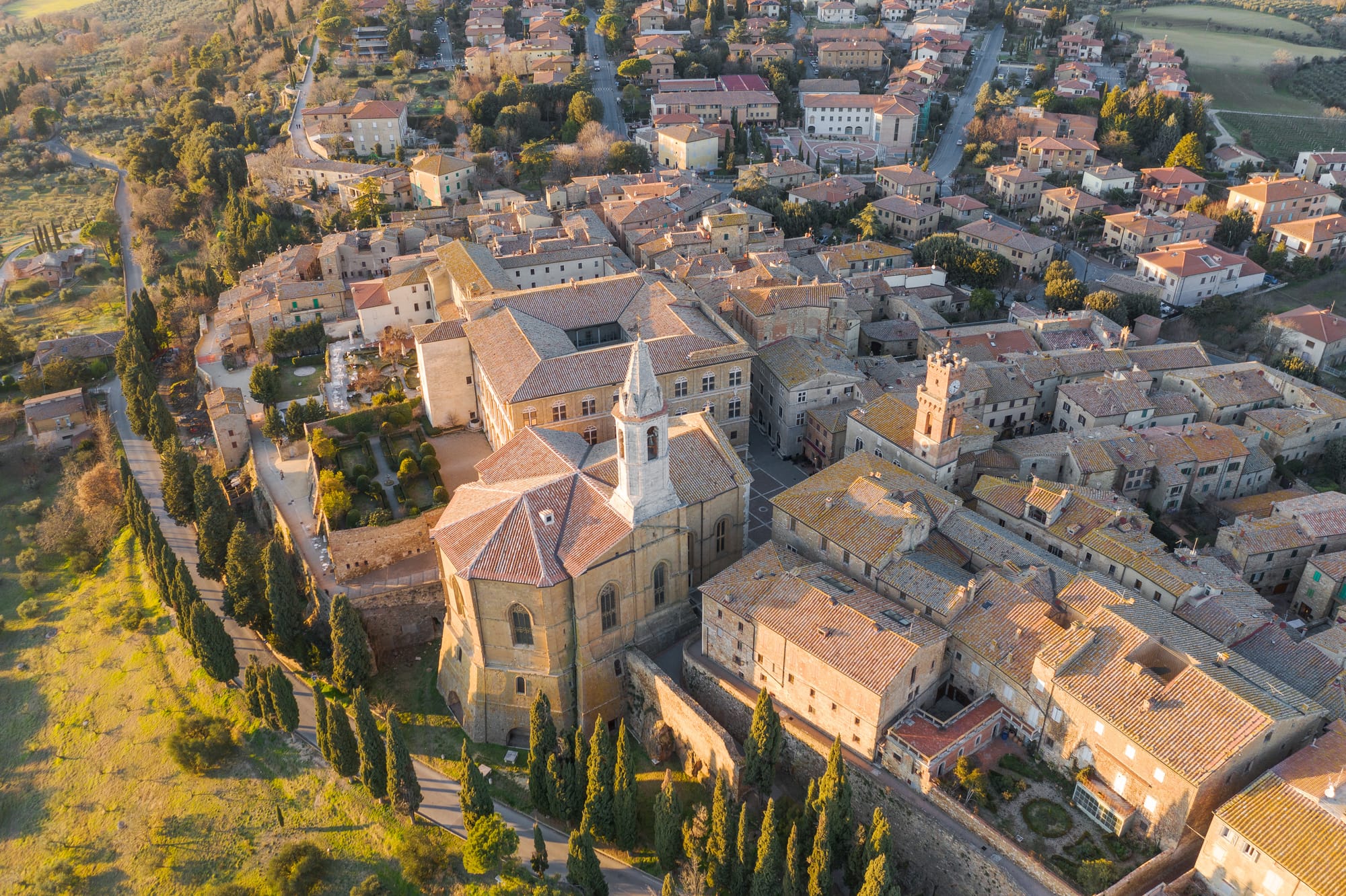
Pienza as a base to explore Val d'Orcia
Pienza's strategic location makes it an unparalleled base for discovering the wider Val d'Orcia region. The iconic landscapes and historic towns that define this UNESCO World Heritage site are all within a short, scenic drive, most under 30 minutes away.
Monticchiello
(Approx. 15-minute drive)
This tiny, perfectly preserved medieval hamlet offers a tranquil escape from the more popular towns. It's a photographer's dream, with charming stone houses and winding alleys.
Montepulciano
(Approx. 20-minute drive)
Known globally for its prestigious red wine, this classic Tuscan hill town boasts elegant Renaissance palaces, ancient cellars, and a lively atmosphere.
Montalcino
(Approx. 30-minute drive)
The famous home of Brunello, one of Italy's most celebrated red wines. The town itself is dominated by a formidable 14th-century fortress that offers incredible views over the surrounding vineyards.
Bagno Vignoni
(Approx. 20-minute drive)
This is one of the most unique villages in all of Italy. Instead of a traditional main square, its center is occupied by a large, ancient pool of steaming thermal water, known since Roman times for its therapeutic properties.
San Quirico d'Orcia
(Approx. 15-minute drive)
This charming and often-overlooked town is a key stop on the ancient Via Francigena pilgrimage route. It features a beautiful Romanesque collegiate church and peaceful historic gardens.
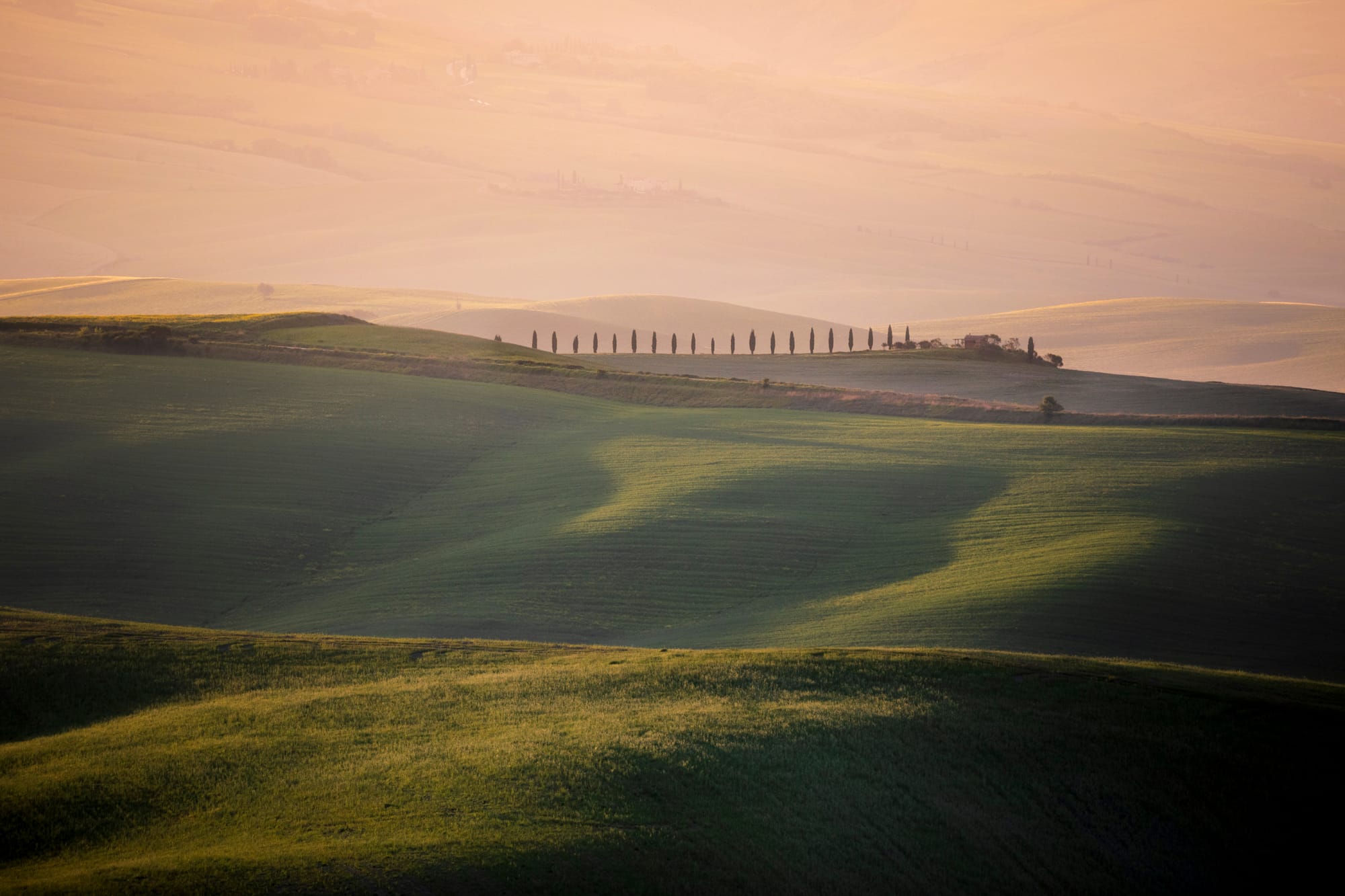
Pienza, a Renaissance dream
Pienza is more than just a destination; it is an idea brought to life. It is a rare place where the principles of the Renaissance—harmony, proportion, and human-centered design—are etched into the very fabric of the town, creating a tangible, utopian vision.
For the cultural traveler who seeks depth and meaning, Pienza is an essential stop on any Tuscan itinerary. It is a town that invites contemplation, rewards curiosity, and leaves an indelible impression of beauty and intellectual grace.
A visit here is a journey into the heart of what makes Tuscany, and Italy, so eternally captivating.
Inspired to plan your journey? Find everything you need at:
- The ultimate guide to Val d'Orcia
- An insider's guide to Siena
- The ultimate guide to Florence
- The essential guide to Tuscany
- The ultimate Tuscany road trip: a 7 to 10-day itinerary
Explore Tuscany like a local with our in-depth guides.
